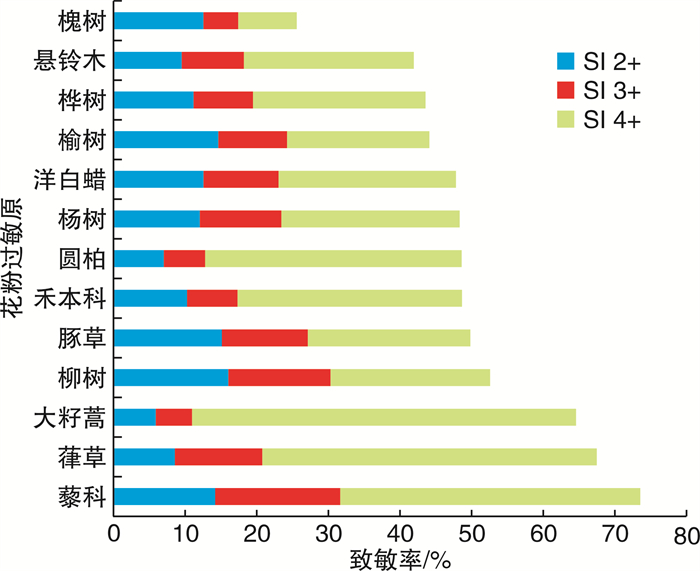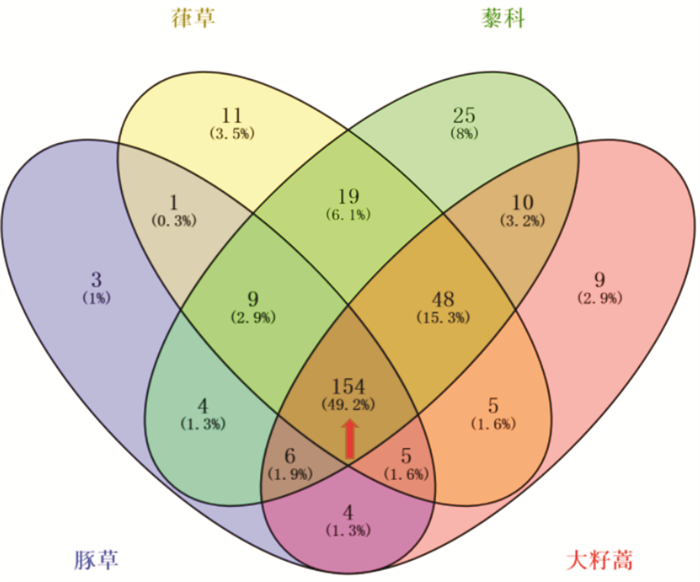Pollen allergen sensitization feature of seasonal allergic rhinitis in children and adolescents in northern China
-
摘要: 目的 对我国北方地区儿童与青少年季节性变应性鼻炎(SAR)致敏花粉的特征进行分析。方法 回顾性分析于北京世纪坛医院变态反应中心确诊为SAR的我国北方地区儿童和青少年患者。皮肤点刺试验(SPT)所用过敏原点刺液为13种北方地区常见花粉。采用SPSS 23.0软件分析花粉过敏原的致敏在年龄、性别、致敏模式等方面的差异。结果 374例SAR患儿纳入研究。最常见的致敏花粉为藜科(73.8%)、葎草(67.6%)、大籽蒿(64.7%);重度致敏率较高的是大籽蒿(53.7%)、葎草(46.8%)、藜科(42.0%)。不同花粉的致敏率及致敏模式无性别差异(P>0.05)。青少年组圆柏致敏率高于儿童组(55.1% vs 42.9%,P=0.023),2组其余花粉过敏原及致敏模式比较差异无统计学意义(P>0.05)。树木花粉的多重致敏率为57.2%,杂草花粉为59.6%。全部花粉的多重致敏率为81.3%。树木花粉间及杂草花粉间均有显著相关性(P < 0.01)。除圆柏外,其他7种树木花粉与草花粉间有显著相关性(P < 0.01)。4种杂草花粉的单一致敏率低(1%~8%),49.2%的患儿对4种杂草花粉均过敏。结论 儿童和青少年期的SAR花粉的致敏率无显著性别及年龄差异。花粉间具有广泛的交叉过敏反应,尤其在杂草花粉间。Abstract: Objective The prevalence of seasonal allergic rhinitis(SAR) is high in children and adolescents population. The aim of this study is to explore the feature of pollen allergen sensitization of SAR in children and adolescents. Method Children and adolescents with self-reported seasonal allergic rhinitis in an allergy center of a tertiary hospital were enrolled and received skin prick test(SPT) of 13 common pollen allergens. SAR was defined with positive SPT to any pollen allergen. SPSS software was applied to analyze the differences in age, gender, sensitization pattern. Result In total, 374(85.6%) SAR cases with self-reported seasonal allergic rhinitis were enrolled, including 213 males (57%) and 161 females (43%). There are 198 children (2-12 years old) and 176 adolescents (13-17 years old). The highest sensitization rate was presented in Chenopodium (73.8%), Humulus(67.6%) and Artemisia (64.7%).The severe sensitization was presented in Artemisia(53.7%), Humulus(46.8%) and Chenopodium (42.0%). No gender difference was found among different pollen allergens and sensitization patterns(P>0.05). No age difference was found between different pollen allergens and sensitization patterns except that Cupressaceae was higher in adolescent group than that in children group(55.1% vs 42.9%, P=0.023). Poly-sensitization rate was 57.2% in tree pollens, 59.6% in weed pollens and 81.3% in total. Significant correlation was found among different tree pollens and weed pollens(P < 0.01). Tree pollen sensitization was significantly correlated with weed pollens except Cupressaceae(P < 0.01). The mono-sensitization rate is low in all 4 weed pollen allergens ranged from 1% to 8% while 49.2% of SAR patients were allergic to all of the 4 weed pollen allergens. Conclusion The prevalent pollen allergens in SAR were similar in children and adolescent comparing to adults. No obvious gender and age differences were found. An extensive co-sensitizations were found among pollens especially in weed pollens.
-
Key words:
- allergic rhinitis /
- pollen /
- tree pollen /
- weed pollen /
- grass pollen /
- poly-sensitization /
- distribution feature
-

-
表 1 SAR患者花粉过敏原致敏率的年龄和性别分布例(%)
过敏原 性别 P 年龄分组 P 总计 男(n=213) 女(n=161) 儿童组(n=198) 青少年组(n=176) 圆柏 99(46.5) 83(51.6) 0.348 85(42.9) 97(55.1) 0.023 182(48.7) 杨树 103(48.4) 78(48.4) 1.000 99(50.0) 82(46.6) 0.535 181(48.4) 柳树 106(49.8) 91(56.5) 0.210 99(50.0) 98(55.7) 0.300 197(52.7) 槐树 54(25.4) 42(26.1) 0.905 50(25.3) 46(26.1) 0.906 96(25.7) 桦树 95(44.6) 68(42.2) 0.674 83(41.9) 80(45.5) 0.531 163(43.6) 悬铃木 92(43.2) 65(40.4) 0.598 76(38.4) 81(46.0) 0.143 157(42.0) 洋白蜡 99(46.5) 80(49.7) 0.601 90(45.5) 89(50.6) 0.351 179(47.9) 榆树 91(42.7) 74(46.0) 0.599 84(42.4) 81(46.0) 0.532 165(44.1) 豚草 106(49.8) 81(50.3) 0.917 93(47.0) 82(53.4) 0.254 187(50.0) 葎草 140(65.7) 113(70.2) 0.374 130(65.7) 123(69.9) 0.438 253(67.6) 藜科 157(73.7) 119(73.9) 0.965 144(72.7) 132(75.0) 0.639 276(73.8) 大籽蒿 139(65.3) 103(64.0) 0.827 127(64.1) 115(65.3) 0.829 242(64.7) 禾本科 104(48.8) 78(48.4) 0.942 93(47.0) 89(50.6) 0.534 182(48.7) 表 2 花粉不同致敏类型在SAR患者中的性别和年龄差异例(%)
过敏原 性别 P 年龄分组 P 总计 男(n=213) 女(n=161) 儿童组(n=198) 青少年组(n=176) 树木花粉 0.624 0.346 单一致敏 22(10.3) 21(13.0) 22(11.1) 21(11.9) 43(11.5) 双重致敏 25(11.7) 16(9.9) 25(12.6) 16(9.1) 41(11.0) 多重致敏 119(55.9) 95(59.0) 106(53.5) 108(61.4) 214(57.2) 任一花粉 166(77.9) 132(82.0) 153(77.3) 145(82.4) 298(79.7) 禾本科花粉 104(48.8) 78(48.4) 0.942 93(47.0) 89(50.6) 0.534 182(48.7) 杂草花粉 0.792 0.471 单一致敏 26(12.2) 22(13.7) 29(14.6) 19(10.8) 48(12.8) 双重致敏 22(10.3) 21(13.0) 19(9.6) 24(13.6) 43(11.5) 多重致敏 129(60.6) 94(58.4) 117(59.1) 106(60.2) 223(59.6) 任一花粉 177(83.1) 137(85.1) 165(83.3) 149(84.7) 314(84.0) 任一花粉 0.476 0.471 单一致敏 23(10.8) 24(14.9) 24(12.1) 23(13.1) 47(12.6) 双重致敏 14(6.6) 9(5.6) 15(7.6) 8(4.5) 23(6.1) 多重致敏 176(82.6) 128(79.5) 159(80.3) 145(82.4) 304(81.3) 任一花粉 190(89.2) 137(85.1) 174(87.9) 153(86.9) 374(100.0) 单一致敏指仅有1种花SPT阳性;双重致敏指2种花粉同时阳性;多重致敏指3种或以上花粉阳性。 表 3 不同花粉过敏原致敏的相关性分析
花粉 圆柏 杨树 柳树 槐树 桦树 悬铃木 白蜡树 榆树 豚草 葎草 藜科 大籽蒿 禾本科 圆柏 r 1 0.385 0.312 0.261 0.288 0.212 0.352 0.234 0.043 0.033 -0.016 0.025 0.037 P 0.000 0.000 0.000 0.000 0.000 0.000 0.000 0.409 0.525 0.759 0.630 0.479 杨树 r 0.385 1 0.564 0.386 0.433 0.477 0.507 0.422 0.177 0.292 0.176 0.234 0.256 P 0.000 0.000 0.000 0.000 0.000 0.000 0.000 0.001 0.000 0.001 0.000 0.000 柳树 r 0.312 0.564 1 0.459 0.444 0.448 0.512 0.508 0.241 0.272 0.239 0.252 0.301 P 0.000 0.000 0.000 0.000 0.000 0.000 0.000 0.000 0.000 0.000 0.000 0.000 槐树 r 0.261 0.386 0.459 1 0.483 0.455 0.417 0.439 0.306 0.197 0.169 0.255 0.322 P 0.000 0.000 0.000 0.000 0.000 0.000 0.000 0.000 0.000 0.001 0.000 0.000 桦树 r 0.288 0.433 0.444 0.483 1 0.629 0.486 0.479 0.243 0.216 0.217 0.277 0.353 P 0.000 0.000 0.000 0.000 0.000 0.000 0.000 0.000 0.000 0.000 0.000 0.000 悬铃木 r 0.212 0.477 0.448 0.455 0.629 1 0.530 0.586 0.276 0.229 0.137 0.277 0.321 P 0.000 0.000 0.000 0.000 0.000 0.000 0.000 0.000 0.000 0.008 0.000 0.000 白蜡树 r 0.352 0.507 0.512 0.417 0.486 0.530 1 0.615 0.273 0.262 0.267 0.204 0.352 P 0.000 0.000 0.000 0.000 0.000 0.000 0.000 0.000 0.000 0.000 0.000 0.000 榆树 r 0.234 0.422 0.508 0.439 0.479 0.586 0.615 1 0.318 0.258 0.187 0.307 0.395 P 0.000 0.000 0.000 0.000 0.000 0.000 0.000 0.000 0.000 0.000 0.000 0.000 豚草 r 0.043 0.177 0.241 0.306 0.243 0.276 0.273 0.318 1 0.497 0.438 0.548 0.524 P 0.409 0.001 0.000 0.000 0.000 0.000 0.000 0.000 0.000 0.000 0.000 0.000 葎草 r 0.033 0.292 0.272 0.197 0.216 0.229 0.262 0.258 0.497 1 0.576 0.590 0.467 P 0.525 0.000 0.000 0.000 0.000 0.000 0.000 0.000 0.000 0.000 0.000 0.000 藜科 r -0.016 0.176 0.239 0.169 0.217 0.137 0.267 0.187 0.438 0.576 1 0.514 0.459 P 0.759 0.001 0.000 0.001 0.000 0.008 0.000 0.000 0.000 0.000 0.000 0.000 大籽蒿 r 0.025 0.234 0.252 0.255 0.277 0.277 0.204 0.307 0.548 0.590 0.514 1 0.630 P 0.630 0.000 0.000 0.000 0.000 0.000 0.000 0.000 0.000 0.000 0.000 0.000 禾本科 r 0.037 0.256 0.301 0.322 0.353 0.321 0.352 0.395 0.524 0.467 0.459 0.630 1 P 0.479 0.000 0.000 0.000 0.000 0.000 0.000 0.000 0.000 0.000 0.000 0.000 -
[1] D'Amato G, Cecchi L, Bonini S, et al. Allergenic pollen and pollen allergy in Europe[J]. Allergy, 2007, 62(9): 976-990. doi: 10.1111/j.1398-9995.2007.01393.x
[2] Jung S, Lee SY, Yoon J, et al. Risk Factors and Comorbidities Associated With the Allergic Rhinitis Phenotype in Children According to the ARIA Classification[J]. Allergy Asthma Immunol Res, 2020, 12(1): 72-85. doi: 10.4168/aair.2020.12.1.72
[3] Ma T, Wang X, Zhuang Y, et al. Prevalence and risk factors for allergic rhinitis in adults and children living in different grassland regions of Inner Mongolia[J]. Allergy, 2020, 75(1): 234-239. doi: 10.1111/all.13941
[4] Wang XY, Ma TT, Wang XY, et al. Prevalence of pollen-induced allergic rhinitis with high pollen exposure in grasslands of northern China[J]. Allergy, 2018, 73(6): 1232-1243. doi: 10.1111/all.13388
[5] 王晓艳, 田宗梅, 宁慧宇, 等. 北京城区气传花粉分布与过敏性疾病就诊关系分析[J]. 临床耳鼻咽喉头颈外科杂志, 2017, 31(10): 757-761. https://www.cnki.com.cn/Article/CJFDTOTAL-LCEH201710006.htm
[6] Marchetti P, Pesce G, Villani S, et al. Pollen concentrations and prevalence of asthma and allergic rhinitis in Italy: Evidence from the GEIRD study[J]. Sci Total Environ, 2017, 584-585: 1093-1099.
[7] Dondi A, Tripodi S, Panetta V, et al. Pollen-induced allergic rhinitis in 1360 Italian children: comorbidities and determinants of severity[J]. Pediatr Allergy Immunol, 2013, 24(8): 742-751. doi: 10.1111/pai.12136
[8] Shrestha SK, Katelaris C, Dharmage SC, et al. High ambient levels of grass, weed and other pollen are associated with asthma admissions in children and adolescents: A large 5-year case-crossover study[J]. Clin Exp Allergy, 2018, 48(11): 1421-1428. doi: 10.1111/cea.13225
[9] Katotomichelakis M, Danielides G, Iliou T, et al. Allergic sensitization prevalence in a children and adolescent population of northeastern Greece region[J]. Int J Pediatr Otorhinolaryngol, 2016, 89: 33-37. doi: 10.1016/j.ijporl.2016.07.027
[10] 秦雅楠, 孙玉霖, 王琳, 等. 青岛地区变应性鼻炎患者变应原分布特点及发病相关危险因素[J]. 临床耳鼻咽喉头颈外科杂志, 2020, 34(1): 36-40. https://www.cnki.com.cn/Article/CJFDTOTAL-LCEH202001009.htm
[11] 李文静, 黄南, 刘光辉. 圆柏花粉浸液40 kD蛋白组分的鉴定[J]. 华中科技大学学报(医学版), 2014, 43(3): 321-323. https://www.cnki.com.cn/Article/CJFDTOTAL-TJYX201403017.htm
[12] Asam C, Hofer H, Wolf M, et al. Tree pollen allergens-an update from a molecular perspective[J]. Allergy, 2015, 70(10): 1201-1211. doi: 10.1111/all.12696
[13] Stemeseder T, Hemmer W, Hawranek T, et al. Marker allergens of weed pollen-basic considerations and diagnostic benefits in the clinical routine: Part 16 of the Series Molecular Allergology[J]. Allergo J Int, 2014, 23(8): 274-280. doi: 10.1007/s40629-014-0033-1
[14] 关凯, 周俊雄, 王瑞琦, 等. 圆柏花粉点刺液诊断圆柏花粉过敏的临床价值[J]. 临床耳鼻咽喉头颈外科杂志, 2018, 32(3): 161-166. https://www.cnki.com.cn/Article/CJFDTOTAL-LCEH201803001.htm
[15] Pfaar O, Karatzas K, Bastl K, et al. Pollen season is reflected on symptom load for grass and birch pollen-induced allergic rhinitis in different geographic areas-An EAACI Task Force Report[J]. Allergy, 2020, 75(5): 1099-1106. doi: 10.1111/all.14111
[16] Ziello C, Sparks TH, Estrella N, et al. Changes to airborne pollen counts across Europe[J]. PLoS One, 2012, 7(4): e34076. doi: 10.1371/journal.pone.0034076
[17] So HJ, Moon SJ, Hwang SY, et al. Characteristics of airborne pollen in Incheon and Seoul(2015-2016)[J]. Asia Pac Allergy, 2017, 7(3): 138-147. doi: 10.5415/apallergy.2017.7.3.138
[18] Medek DE, Beggs PJ, Erbas B, et al. Regional and seasonal variation in airborne grass pollen levels between cities of Australia and New Zealand[J]. Aerobiologia(Bologna), 2016, 32(2): 289-302. doi: 10.1007/s10453-015-9399-x
[19] Yamamoto N, Matsuki Y, Yokoyama H, et al. Relationships among indoor, outdoor, and personal airborne Japanese cedar pollen counts[J]. PLoS One, 2015, 10(6): e0131710. doi: 10.1371/journal.pone.0131710
[20] Gao Z, Fu WY, Sun Y, et al. Artemisia pollen allergy in China: Component-resolved diagnosis reveals allergic asthma patients have significant multiple allergen sensitization[J]. Allergy, 2019, 74(2): 284-293. doi: 10.1111/all.13597
[21] 娄鸿飞, 马思远, 赵岩, 等. 北京地区变应性鼻炎患者的优化吸入过敏原谱研究[J]. 临床耳鼻咽喉头颈外科杂志, 2018, 32(1): 37-42. https://www.cnki.com.cn/Article/CJFDTOTAL-LCEH201801008.htm
-





 下载:
下载:
